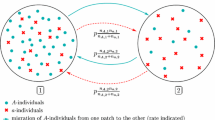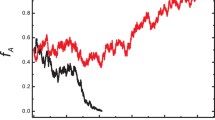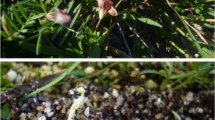Abstract
We propose and solve a stochastic mathematical model of general applicability to interbreeding populations which share the same habitat. Resources are limited so that the total population size is fixed by environmental factors. Interbreeding occurs during all the time of coexistence until one of the two population disappears by a random fluctuation. None of the two populations has a selective advantage. We answer the following questions: How long the two populations coexist and how genetically similar they become before the extinction of one of the two? how much the genetic makeup of the surviving population changes by the contribution of the disappearing one? what it is the number of interbreeding events given the observed introgression of genetic material? The model was originally motivated by a paleoanthropological problem concerning the interbreeding of Neanderthals and African modern humans in Middle East which is responsible for the fraction of Neanderthal genes (1–4 %) in present Eurasian population.
Similar content being viewed by others
References
Bar-Yosef O (1998) The chronology of the middle paleolithic of the levant. In: Akazawa T, Aoki K, Bar-Yosef O (eds) Neandertals and modern humans in western Asia. Springer, New York, p 3956
Chang JT (1999) Recent common ancestors of all present-day individuals. Adv Appl Probab 31:10021026
Derrida B, Manrubia SC, Zanette DH (1999) Statistical properties of genealogical trees. Phys Rev Lett 82:19871990
Durrett R (2008) Probability models for DNA sequence evolution. In: Asmussen S, Gani J, Jagers P, Kurtz ThG (eds) Probability and its applications, 2nd edn. Springer, New York, pp 252–253
Fu Q, Hajdinjak M, Moldovan OT, Constantin S et al (2015) An early modern human from Romania with a recent Neanderthal ancestor. Nature 524:216219
Green RE, Krause J, Briggs AW, Maricic T, Stenzel U et al (2010) A draft sequence of the Neandertal genome. Science 328:710722
Hammer MF, Woerner AE, Mendez FL, Watkins JC, Wall JD (2011) Genetic evidence for archaic admixture in Africa. Proc Natl Acad Sci 468(37):512315128
Neves AGM (2012) Interbreeding conditions for explaining Neandertal DNA in living humans: the nonneutral case. In: Mondaini RP, Dilão R (eds) BIOMAT 2011. World Scientific, Singapore
Neves AGM, Serva M (2012) Extremely rare interbreeding events can explain Neandertal DNA in living humans. PLoS One 7(10):e47076
Reich D, Green RE, Kircher M, Krause J, Patterson N et al (2010) Genetic history of an archaic hominin group from Denisova cave in Siberia. Nature 468:10531060
Sankararaman S, Patterson N, Li H, Pääbo S, Reich D, Akey JM (2012) The date of Interbreeding between Neandertals and modern humans. PLoS Genet 8(10):e1002947
Serva M (2005) On the genealogy of populations: trees, branches and offspring. J Stat Mech: Theory Exp P07011
Traulsen A, Claussen JC, Hauert C (2005) Coevolutionary dynamics: from finite to infinite populations. Phys Rev Lett 95:238701
Acknowledgments
We are very grateful to Josè Fontanari, Armando Neves and Simone Pigolotti for many illuminating discussions, suggestions and encouragement.
Author information
Authors and Affiliations
Corresponding author
Rights and permissions
About this article
Cite this article
Serva, M. A Stochastic Model for the Interbreeding of Two Populations Continuously Sharing the Same Habitat. Bull Math Biol 77, 2354–2365 (2015). https://doi.org/10.1007/s11538-015-0127-z
Received:
Accepted:
Published:
Issue Date:
DOI: https://doi.org/10.1007/s11538-015-0127-z




